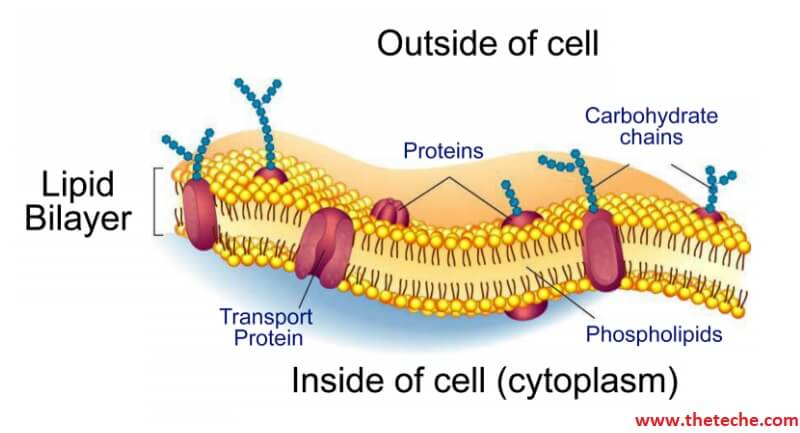Immediately below the cell wall, plasma membrane is present which is also known as cytoplasmic membrane, inner membrane, or cell membrane. In prokaryotes, plasma membrane thickness is about 7.5nm (0.0075μm).
Phospholipids : These constitute 40% of the plasma membrane and are arranged in two parallel layers, thus known as phospholipid bilayer. Its each molecule has two components:
- Polar Head: It comprises of phosphate group and glycerol. It is hydrophilic (water-loving), therefore is soluble in water.
- Non-Polar Tails: Fatty acids being the main component makes them hydrophobic (water-fearing), therefore are insoluble in water.
On both surfaces of the bilayer, polar heads are present. Inside the bilayer, non-polar tails are found. Bacterial membranes lack sterols and high molecular weight lipids, except the wall-less prokaryotic mycoplasma (they contain membrane sterols). Sterols and high molecular weight lipids are commonly present in eukaryotic cells.
After studying the phospholipids present in bacteria (eubacteria) and in archae bacteria, it is concluded that in bacteria, the phospholipids are phosphoglycerides having straight-chain fatty acids ester-linked to glycerol; whereas in archaebacteria, lipids are poly isoprenoid branched-chain lipids having branched long-chain alcohols (phytanols) which are ether-linked to glycerol.
Functions
- These are building blocks for cell membranes in all organisms.
- These are transducer of biological signals across the membrane.
- These are efficient storage of energy, like triglycerides.
- These play an important role in the transportation of fat between gut and liver in mammalian digestion.
- These are the source of acetylcholine (a neurotransmitter present in mammals).
Proteins : These constitute 60% of the plasma membrane and are situated randomly in lipid bilayer. Some proteins are present on periphery of membrane, but loosely attached and are known as peripheral proteins or peripheral membrane proteins, which constitute about 20−30% of total membrane protein. These bound to the hydrophilic layer of membrane through charge interaction.
About 70−80% of membrane proteins are present within the membrane matrix and constitute integral proteins or trans-membrane proteins or membrane-integral proteins. They are present throughout the bilayers and are bound to fatty acid chains by hydrophobic amino acid residues. Few proteins act as channels for substances to enter and exit the cell. These peripheral proteins normally bound to the hydrophilic layer of membrane by charge interaction.
Functions of Plasma Membrane
It is actively involved in the regulation of the flow of materials inside and outside the cell. It acts as a differentially permeable barrier, that permit smaller molecules (like water, oxygen, carbon dioxide, and simple sugars) to pass. Larger molecules cannot move freely across the membrane. The bacterial cell membrane excretes out molecular waste products outside the cell.
It acts as an osmotic barrier that maintains intracellular osmotic pressure for the cell.
It provides site for many important enzymatic reactions, e.g., in respiratory metabolism and during synthesis of capsule and cell wall components. Its impermeability to protons (hydrogen ions) results to the site for generation of the proton-motive force, that drives ATP production, some nutrient transport systems, and flagellar motility.
Any damage to membrane through physical or chemical agents results in cell death.
It also participates in replication of DNA attached to the membrane. Newly formed DNA molecules are physically separated through newly formed individual cell membrane.
| Read More Topics |
| Ultrastructure of bacterial cell |
| Difference between Prokaryotic and Eukaryotic Cells |
| The prime features of a prokaryotic cell |
| Function of autonomic nervous system |






